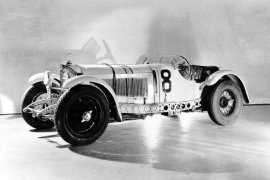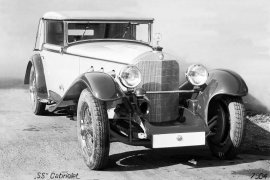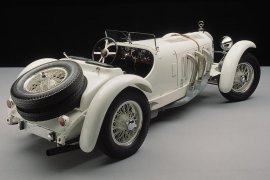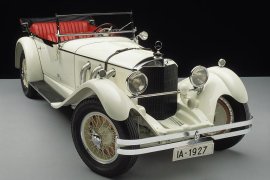MERCEDES BENZ Typ S, SS, SSK, SSKL Models/Series Timeline, Specifications & Photos
First production year: 1927
Engines: Gasoline
Body style: Convertible (spider/spyder, cabrio/cabriolet, drop/open/soft top)
The 1931 Mercedes-Benz SSKL was the car that broke records, wrote history, and sent its competitors back to the drawing board.
Its story began before the merger of the two companies that formed Mercedes-Benz to be completed. Back in the '20s, Daimler-Motoren-Gesellschaft (DMG) started to work on a supercharged racing car. The technical director who worked on the project was Paul Daimler, son of Gottlieb Daimler, the founder of the company. He already had enough experience with supercharged engines developed for aircraft and submarines.
The SSKL was based on the same chassis as the rest of the W06 range, although it was lighter and featured a shorter wheelbase. Mercedes-Benz tried to get a better name at the Mille Miglia racing event. A win there would have meant a huge marketing boost for the carmaker. So, MB's engineers made a lighter version for the already known and appreciated SSK. The result was a 1,350 kg (2,976 lbs) roadster. Its front suspension, consisting of leaf springs, was supported by arched steel beams extended in front of the chassis. The carmaker supported the arched wheel fenders and the triple-headlamp system. On the sides, the bodywork was flush and featured just two seats. Underneath the bodywork, the chassis sported big holes in it to lighten the vehicle. It was a daring move, but it paid off.
On 12/13 April 1931, Rudolf Caracciola wrote history with the SSKL when he won the Mille Miglia race in Italy. They averaged 101.1 kph (62.82 mph) in the race. That was possible thanks to the 7.7-liter supercharged powerplant that delivered 300 hp.
MERCEDES BENZ Typ SSKL (WS06 RS) 7.1 Kompressor (27/240/300)
Mercedes-Benz introduced the W06 range in 1927, starting with the model S, which was built as a sports car and for sporting events, followed by the SS in 1928.
The German carmaker knew that its name would be on everybody's lips if it was going to win races, so it focused on developing a sports car. Thus, the S version won the German Grand Prix in 1927, and those interested in faster vehicles asked for more. And thus, the carmaker introduced the SS model in the following year. It was the Super Sports car of the moment, a symbol of luxury and speed, and a grand tourer.
Like many other models from Mercedes' lineup, the SS was available in a few shapes or as a bare chassis. But all of them shared the same V-shaped radiator grille. The front wheels were pushed forward in front of the radiator and engine compartment, and the chromed bar that supported the headlights was mounted between the arched front fenders. In addition, the carmaker added a bumper mounted on the chassis' endings to protect the vehicle in case of an accident. The rounded shape of the hood was carried over for a few decades afterward. Finally, to protect the car's occupants, Mercedes-Benz added a short, flat windshield fitted with a pair of wipers on the upper side.
But the carmaker knew its clients enjoyed luxurious vehicles, so it fitted the cabin with expensive materials. Two or four seats were inside depending on what kind of bodywork they chose. Another version featured tumbling seats behind the cabin and the rear axle.
Under the hood stood a big, 7.1-liter engine that produced 200 hp in the low-power version, with an option for a 225 hp. But for those who had deeper pockets and a need for speed, there was a special set of camshafts that could help the engine produce up to 275 hp. The carmaker produced 111 units of this SS model between 1928 and 1933, but the car stayed on the price lists until 1935.
After the success recorded with the regular W06 in 1927, the German automaker tried to create an even sportier vehicle, and that's how the SSK was born in 1928.
The world was hungry for more power and more performance. Thus, Mercedes-Benz tried to create a vehicle that could satisfy the day's deep-pocket people and imagined a short-wheelbase version for the regular W06 SS. These letters came from Super Sport, and the K came from the "Kurts," meaning "Short" in German. The car was designed by a 52-year-old engineer by the name of Ferdinand Porsche. It was the last car created by him for the three-pointed star brand.
At the front, the SSK featured a similar-looking V-shaped radiator grille placed well behind the chassis' front ends. It was flanked by two rounded exposed fenders that were connected via a chromed bar, which in turn supported the headlights. Unlike its S sibling, the SSK featured cut-out side doors so the occupants could climb aboard. The short and flat-folding windshield protected the driver and the passenger from wind, dust, and flies. Not from elements.
The cockpit was cramped due to the shorter wheelbase than the one offered on the W06 S model. Moreover, behind the cabin, the car ended abruptly. Still, the carmaker considered adding a removable trunk that was more of an oversized suitcase rather than a luggage compartment.
Under the car's hood, Mercedes-Benz installed a huge inline-six supercharged powerplant. It developed enough power to propel the car at speeds up to 190 kph (118 mph). But its drum brakes in all corners made stopping difficult.
The German automaker introduced the W06 lineup in 1927, and the Typ S was among the first to appear in front of customers as a promise of a high-performance luxury vehicle.
Despite sporting a four-seat bodywork, the Typ S was so fast that it actually won the German Grand Prix in 1927. Suddenly, the luxurious brand became known for its performances, not just for its luxurious vehicles. In addition, the new W06 lineup came with many improvements for the drivetrain and suspension that made it not only a comfortable vehicle on long roads for those times' standards but also a very capable machine during high-speed cornering.
Like the rest of the range, the Typ S featured a V-shaped radiator grille placed behind the chromed bumper. Between the curved front fenders, the carmaker installed a cross-bar that supported the big and round headlights, which didn't obstruct the radiator's cooling area. One of the unique characteristics of the car was seen on the passenger's side of the vehicle, where three exhausts peaked out from within the engine compartment downwards and went to the back underneath the side steps. The curved chassis allowed the vehicle to sport a lower ground clearance than many cars from that era.
The cabin was fitted with two bucket seats at the front and a bench in the rear. As expected, the rear ones were removed during races. On the dash panel, Mercedes-Benz installed the dials in the middle, so the driver could see them easily without peaking through the four-spoke wooden steering wheel. Just like its other luxurious siblings, the Typ S featured expensive materials in the cabin.
Under the long hood, Mercedes-Benz installed a 6.8-liter inline-six engine. It was paired with a four-speed manual that sent the power to the rear live axle.



